The best lenses for Nikon D610 at an affordable prices.
The Nikon D610 is the best camera model in this price category. It is a full-frame camera that costs around $1,500 for the body alone.
I have compiled the list of the best lenses for Nikon D610. It includes kits options, prime and zoom lenses from wide-angle to telephoto.
The Nikon D610 has a 39 point AF system with a central cross-type AF point. Its native ISO range is 100–25600 which can be improved to 102400. This camera allows you to shoot full HD videos at a maximum frame rate of 30 fps.
But it's also important to choose the best lens for Nikon D610 for taking amazing photos.

Mount: Nikon F | Diaphragm blades: 9 | Autofocus: Yes | Min focus distance: 2.2m | Max magnification: 0.22x | Filter thread: 95mm | Dimensions (WxL): 108x268mm | Weight: 2300g
⊕ Sharp optics
⊕ Long telephoto reach
⊕ Fixed f/5.6 max aperture
⊕ Optical stabilization
⊕ A removable tripod collar
⊖ Competing lenses have better magnification
Being one of the most affordable Nikon D610 lenses, it features really crisp optics and a narrow aperture. In such a way, the weight of the lens is manageable while the price is not high.
It is a good buy in comparison with the shorter but faster AF-S Nikkor 200-400mm f/4G ED VR II. However, if you compare these models with other options in this category, you will see that its competitors offer better magnification.
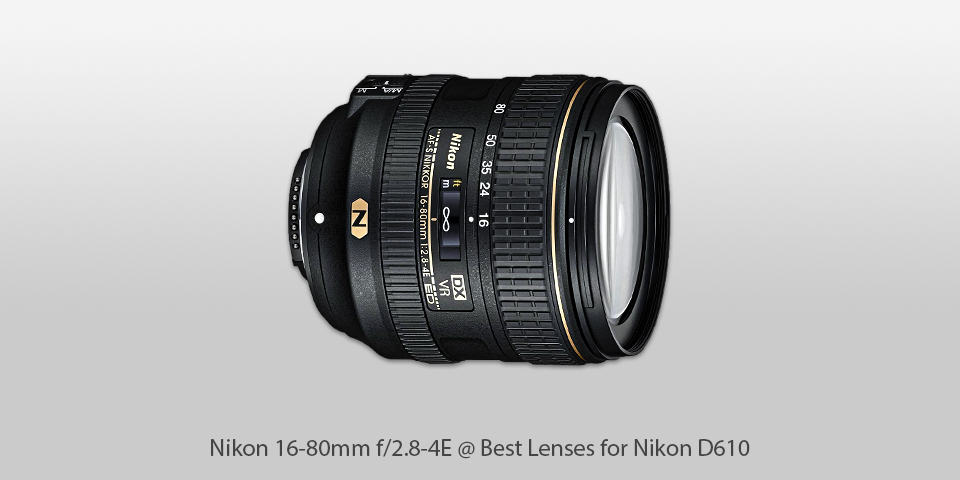
Mount: Nikon F | Diaphragm blades: 7 | Autofocus: Yes | Min focus distance: 0.35m | Max magnification: 0.22x | Filter thread: 72mm | Dimensions (WxL): 80 x 85.5mm | Weight: 480g
⊕ Sharp
⊕ Compact body
⊕ 5x optical zoom
⊕ Image stabilization
⊖ Costly
⊖ Visible distortion
The Nikon AF-S DX Nikkor 16-80mm f/2.8-4E ED VR was developed as a kit lens for the D500, a professional camera by Nikon. However, its design and optical quality deliver better performance than standard lenses. It has a longer zoom range and captures more light than 18-55 mm.
Even if you buy this lens along with a camera, it will cost you around $1,000. So, if you are not ready to invest in such expensive gear, you may consider some cheaper Nikon D610 lenses, like the Sigma 17-70mm F2.8-4 DC Macro OS HSM. Although it offers a slightly limited zoom range, this option won’t cost you an arm and a leg.

Mount: Nikon F | Diaphragm blades: 9 | Autofocus: Yes | Min focus distance: 27.69m | Max magnification: 0.14x | Filter thread: None | Dimensions (WxL): 90.7 x 129.8mm | Weight: 950g
⊕ Great sharpness
⊕ Low distortion
⊕ Short min focus distance
⊕ Compatible with multiple systems
⊖ Heavy
⊖ Dim corners and edges
⊖ Doesn’t support filters
Sigma’s Art series of f/1.4 prime lenses features high-quality models showing great performance. Their latest lens, the 20mm F1.4 DG HSM Art for $899, proves that. It’s one of the best lenses for Nikon D610 as it captures sharp, ultra-wide images and allows for a close focus.
You can easily blur the background drawing the viewer’s attention to the subject in the foreground. Barrel distortion is almost absent, but edges and corners seem noticeably dimmer. However, you can correct it using image editing programs. If you need a high-quality ultra-wide lens, this option is exactly what you are looking for.
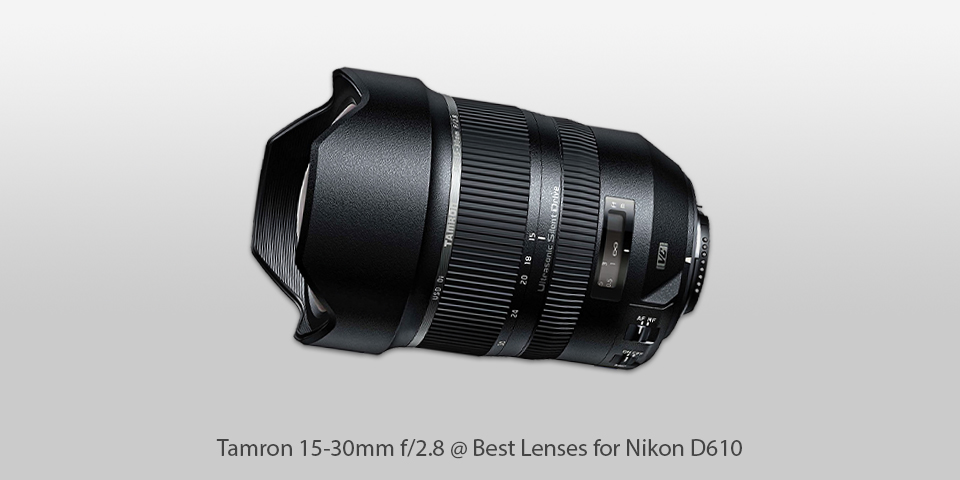
Mount: Nikon F | Diaphragm blades: 9 | Autofocus: Yes | Min focus distance: 0.28m | Max magnification: 0.2x | Filter thread: None | Dimensions (WxL): 98.4 x 142.5mm | Weight: 1100g
⊕ Bright f/2.8 aperture
⊕ Optical stabilization
⊕ Ultra-wide angle of view
⊕ Full-frame compatibility
⊕ Heavy barrel distortion
⊖ No rear filters support
Although the second version of the Tamron’s 15-30mm f/2.8 ultra-wide zoom doesn’t offer great updates in comparison with the first one, it features improved lens coatings.
In addition, this lens combines an original design, bright aperture and optical stabilization. Mind that these parameters are not typical for this type of lens. However, there are some essential drawbacks that I can’t omit. For instance, it doesn’t allow using standard filters and weighs almost 2.5 pounds.
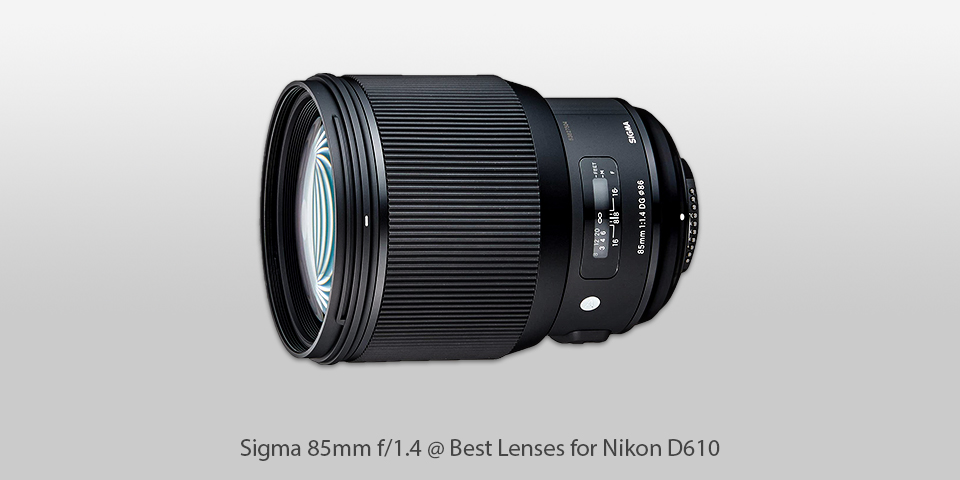
Mount: Nikon F | Diaphragm blades: 9 | Autofocus: Yes | Min focus distance: 0.85m | Max magnification: 0.12x | Filter thread: 86mm | Dimensions (WxL): 94.7 x 126.2mm | Weight: 1113g
⊕ Impressively sharp
⊕ Bright f/1.4 aperture
⊕ No distortion
⊕ Even illumination
⊕ Compatible with multiple systems
⊖ Big and heavy
⊖ No image stabilization
Sigma’s Art series of prime lenses is known for extremely sharp pictures even when you take them at a large aperture. What is more, these lenses are available at affordable prices, and the 85mm F1.4 DG HSM Art ($1,199) is a vivid illustration of that.
Being cheaper than the Nikkor 85mm f/1.4G and the Canon EF 85mm f/1.2L ($1,899), it still delivers great performance. Although it doesn’t have image stabilization, it is a great option to consider. If IS is more important for you than an f/1.4 design, take a look at the Tamron SP 85mm f/1.8 Di VC USD, which is superb in its own right.
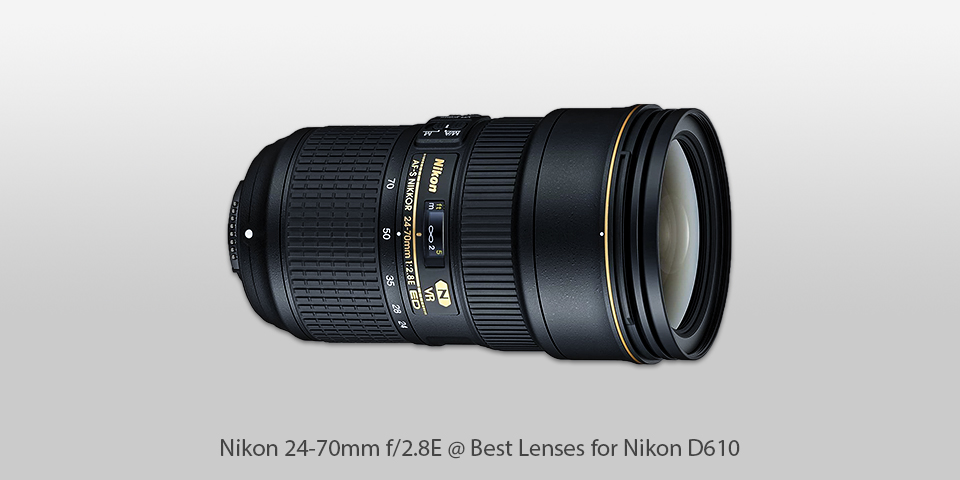
Mount: Nikon F | Diaphragm blades: 9 | Autofocus: Yes | Min focus distance: 0.38m | Max magnification: 0.27x | Filter thread: 82mm | Dimensions (WxL): 88 x 154.5mm | Weight: 1070g
⊕ Optically stabilized design
⊕ Constant f/2.8 aperture
⊕ Great sharpness
⊕ Solid build
⊖ Some distortion
⊖ Expensive
The AF-S Nikkor 24-70mm f/2.8G ED was first released in 2007 and since then it has been used as a working lens by many professional shooters. Then, a new option appeared, the AF-S Nikkor 24-70mm f/2.8E ED VR. The name is almost the same but the cost is much higher. Mind that VR in the name indicates that the lens has a vibration reduction option.
When it comes to Nikon lenses, this term stands for image stabilization. Consequently, this model can be called one of the best lenses for Nikon D610 if you compare it to other full-frame standard f/2.8 options, regardless of the camera system.
Shooters who work without flash, for example, event photographers, and those working with a Nikon SLR for handheld videography should consider this lens.
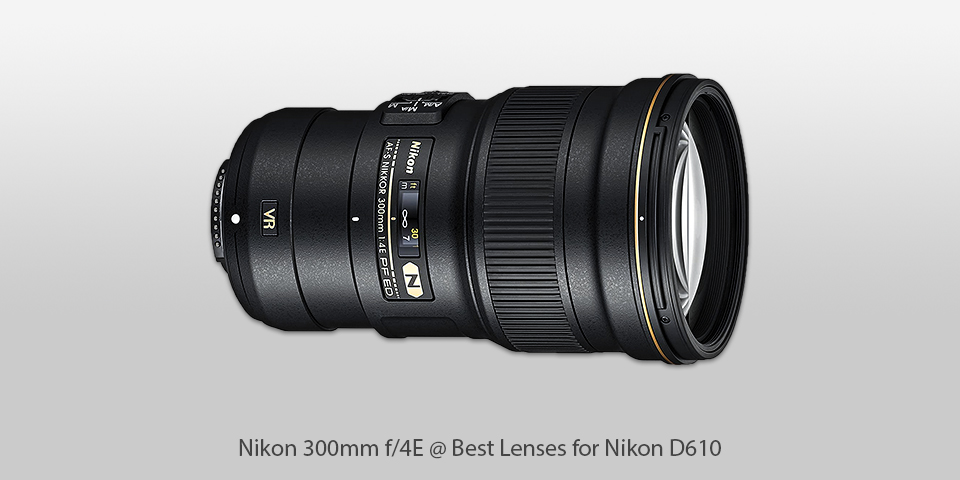
Mount: Nikon F | Diaphragm blades: 9 | Autofocus: Yes | Min focus distance: 1.4m | Max magnification: 0.24x | Filter thread: 77mm | Dimensions (WxL): 89 x 147.5mm | Weight: 755g
⊕ Lightweight body
⊕ Sharp from edge to edge
⊕ Optically stabilized
⊕ 1:4 magnification
⊖ Expensive
If you are looking for the most compact and lightweight optics to fit your D610, the Nikon AF-S Nikkor 300mm f/4E PF ED VR is exactly like this. It is lighter than other prime Nikon D610 lenses of this focal length that cover a full-frame sensor. Thanks to a Phase Fresnel (PF) lens element, its sharpness, close focus capability and image stabilization are equally impressive.
However, if magnification is the priority for you, I recommend choosing the Sigma 150-600mm f/5-6.3 DG OS HSM Contemporary ($779.00 at Amazon). Mind that it is much heavier and bigger than the Nikkor and doesn’t capture as much light at any point in its focal range.
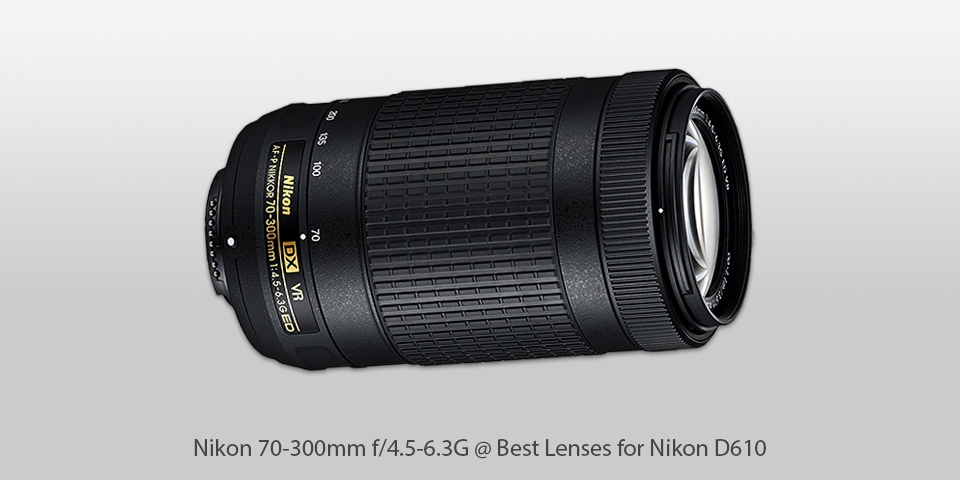
Mount: Nikon F | Diaphragm blades: 7 | Autofocus: Yes | Min focus distance: 1.1m | Max magnification: 0.22x | Filter thread: 58mm | Dimensions (WxL): 72 x 125mm | Weight: 415g
⊕ Lightweight and compact
⊕ Long telephoto reach
⊕ Impressive image stabilization
⊕ Great image quality
⊖ Narrow aperture
⊖ Manual focus is not the best possible
If you are not limited in your budget and don’t mind using a big, heavy lens, you will easily find a high-quality telezoom. However, it might be challenging to find a lightweight lens with decent performance. It’s even harder to find such optics at a budget price.
The Nikon AF-P DX Nikkor 70-300mm f/4.5-6.3G ED VR is an affordable lens with a narrow aperture and an image circle that only covers the DX (APS-C) sensor format. What is more, it is lightweight and compact.
Although it loses a bit of resolution when extended to 300mm, it provides sharp images at every focal length. It is a great budget option for shooters who don’t use a full-frame camera.
| Image | Name | Features | |
|---|---|---|---|
 |
Nikon 200-500mm f/5.6E
Our Choice |
CHECK PRICE→ | |
 |
Nikon 16-80mm f/2.8-4E
Professional |
CHECK PRICE → | |
 |
Sigma 20mm F1.4 Art
Budget |
CHECK PRICE → |

As rule, kit lenses coming with DSLRs are multipurpose ones. If you are just a beginner in photography and don’t clearly know what genre you want to work in, get a high-quality multipurpose lens. Pay attention to a zoom range and a fast aperture when making your choice.
Besides portraits and wedding photographs, this category includes any images depicting people. To get great pictures, it’s better to use lenses with long focal lengths. They soften lines and wrinkles. With such lenses, you will easily blur the background to make it look dreamy. To achieve this effect, use prime lenses with a focal length ranging from 50 mm to 135 mm.
If you are looking for the best lenses for Nikon D610 to cover sports, pick an option with a long focal length, a wide aperture, image stabilization and fast autofocus. I recommend getting a high-grade telephoto lens of 70 mm to 300 mm focal length that has an f2.8 aperture and a decent zoom.
When it comes to landscape photography, it is recommended to use an ultra-wide zoom lens. However, you can successfully take close-range shots with a standard prime lens. If you are considering multipurpose lenses, try using a long-range zoom lens with a focal length of up to 200 mm.

Thanks to its advanced features and great performance, the Nikon D610 used to be one of the best cameras on the market. Even now, when new improved cameras were released, the D610 remains a leader in the world of photography. That is why beginners and professionals are looking for the best lenses for Nikon D610. Find the lens suitable for your photography genre and feel free to experiment.
To begin with, Nikon’s sharpest lens is not the most expensive one. It has an instant focus and no distortion. What is more, it is the smallest and lightest lens. Finally, it is among the fastest Nikon D610 lenses and covers film and the full FX frame.
The Nikon D610 is an upgraded version of the D600. It has better responsiveness and performance than the previous model. Manufacturers made all the necessary improvements and created the D610. Even now it can easily compete with more recent models.
To begin with, it is an impressive camera. Many professional shooters usually have several cameras. Actually, if you are a pro photographer, two cameras is a must. You can take such a top camera as the D810 and use the D610 as a backup option.
Yes, you can. You can interchangeably use DX lenses and FX lenses. If you have purchased a DX-format DSLR camera, your full-frame FX lenses will still work.

 Rating
Rating